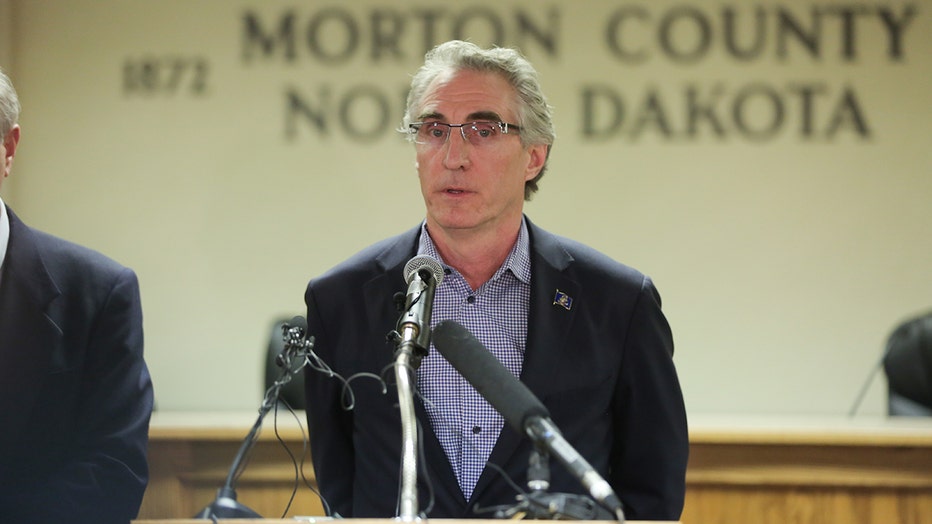Nurses with COVID-19 allowed to work in North Dakota amid staffing shortage
LOS ANGELES - Daily coronavirus cases in North Dakota have risen to record levels, putting an enormous strain on hospital capacity. In an effort to ease the pressure on hospitals in the state, North Dakota officials will allow nurses who are actively infected with COVID-19 to continue to work.
In a press conference held Monday, Gov. Doug Burgum said rising coronavirus cases were putting a strain on hospital capacity in the state.
“Just in the last few days, our hospitalizations, due to COVID, rose by another 10 percent to 254 [hospitalizations], and that’s 60 percent higher than just four weeks ago when we had 158 individuals hospitalized due to COVID,” Burgum said. “We also have seen over the weekend record days Friday, Saturday, Sunday and today really strong new active cases.”

North Dakota Governor Doug Burgum speaks during a press conference announcing plans for the clean up of the Oceti Sakowin protest camp on February 22, 2017 in Mandan, North Dakota.
Burgum announced that asymptomatic COVID-19 positive health care workers could return to work.
“This applies only to COVID positive health care workers who do not have symptoms, and they are allowed only to work in COVID units around patients who already have the virus,” Burgum said.
But the policy drew criticism from some health experts, who said the move could serve to “worsen the epidemic.”
RELATED: US hospitalizations hit record high amid coronavirus surge
“I was aghast when I saw Gov. Burgum announce that he was advocating for COVID positive nurses to continue to work at hospitals. My first thought was: Is he crazy?” Dr. Steffanie Strathdee, associate dean of global health at UC San Diego, told Forbes. “It is precisely why we need a national mitigation plan for COVID-19, so we can prevent governors from enacting ill-informed deadly public policies that will worsen the epidemic instead of alleviating it.”
North Dakota identified its first case of COVID-19 on March 11. It took the state over 200 days — until Oct. 19 — to rise to 5,000 COVID-19 recorded cases. But in the last three weeks alone, the state surpassed 10,000 cases of the novel coronavirus.
“It took us seven months to get to 5,000, and it took us three weeks to get to 10,000,” Burgum said.
While testing increased slightly since October, Burgum said the positivity rate has drastically increased.
“It’s more prevalence, more community spread, and that’s what is causing this accelerating capacity,” Burgum said.
RELATED: US adds more than 1M COVID-19 cases in November alone
Some hospitals in the state also plan to suspend some elective surgeries.
North Dakota saw its largest one-day spike on Nov. 6 with 1,349 new COVID-19 cases, according to data from John Hopkins University.
There is currently no statewide mask mandate in North Dakota, but Burgum has pleaded with people to wear facial coverings, and praised local towns and cities that have mandated masks. But he has avoided implementing a rule for the entire state, according to the Associated Press.
The U.S. surpassed 1 million new confirmed coronavirus cases in just the first 10 days of November, with more than 100,000 infections each day becoming the norm in a surge that shows no signs of slowing. As of Tuesday, Nov. 10, there were over 10.3 million confirmed cases in the U.S. and more than 240,000 deaths.
The U.S. also hit a record number of coronavirus hospitalizations Tuesday, suggesting that the new wave is bigger and more widespread than the surges that happened in the spring and summer — and likely worse.

Nurse Nick Brideau (L), from the ICU COVID unit, and Nurse Karen Hayes administer care to a patient who has just been transferred to the acute care COVID unit at Harborview Medical Center on May 7, 2020 in Seattle, Washington. (Photo by Karen Ducey/G
And unlike the earlier outbreaks, this one is not confined to a region or two, according to the Associated Press.
“The virus is spreading in a largely uncontrolled fashion across the vast majority of the country,” said Dr. William Schaffner, an infectious-disease expert at Vanderbilt University.
Many experts and scientists believe that the nation may be better able to deal with the coronavirus outbreak this fall and winter.
“We’re definitely in a better place” when it comes to improved medical tools and knowledge, William Hanage, a Harvard University infectious-disease researcher, told the Associated Press.
In September, the University of Washington’s Institute of Health Metrics and Evaluation (IHME) predicted an estimated 30,000 deaths from COVID-19 each day in the Northern Hemisphere as winter falls, but said nearly 770,000 lives worldwide could be saved by Jan. 1 through coronavirus preventive measures suggested by the Centers for Disease Control and Prevention, including mask-wearing and social distancing.


